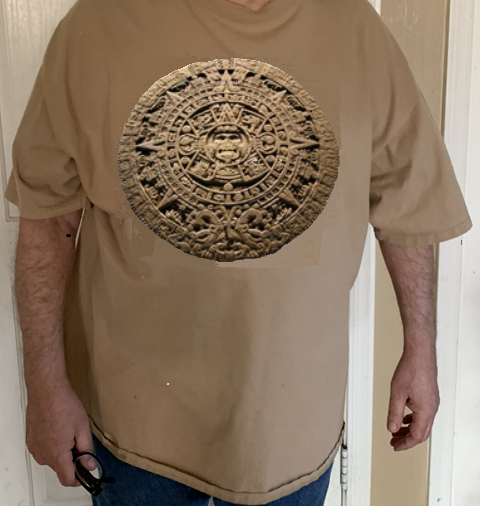There hangs in my closet a shirt so old, a thriving Aztec civilization was playing ball on its courts when the shirt was made.
That’s an old shirt.
It is said the shirt was made at the peak of the Mexica — which is what the Aztecs called themselves — civilization in 1520.
That is 503 years ago.
- 183,595 days ago.
- 4,406,280 hours ago.
- 264,376,800 minutes ago.
- 1.58 billion seconds ago.
More or less.
How time flies when you’re counting nanoseconds. I won’t go there.
Mathematics
I broke down the numbers so you understand how the Aztecs saw the world.
To the Mexica the universe is made of numbers, and math moves the numerals into equations that transform into matter and then action.
Everything — birth, life, death, the seasons with planting and harvests based on astronomy, architecture, human sacrifice and even love — in the end it is all encompassed in mathematics.
The Shirt
How is it possible that I own such a shirt?
The shirt is magic; it finds its host.
It found me in the Arizona desert where an old man lived in a small adobe home near the Sierra Estrella southwest of Phoenix.
The man, who looked as old as he claimed the shirt was, said the shirt brought me to him, and this article of clothing belonged to me now.
You probably think I’m a little loose in the head, and I understand.
Origins
This shirt, I won’t call it mine, because I feel I am his’ or hers’ or its’, whatever the heck it is?
This piece of clothing was made from reed fibers that grew on the shores of Lake Texcoco near the seat of power when the Aztecs were ascendent.
Strong fibers, reduced to smaller fibers of a specific number and braided, produced the strongest cloth ever made; then the shirt was infused with a brujo’s sorcery.
Brujos
Brujos are male witches –call them warlocks, witchdoctors, whatever — who know the secrets of plants. They are properly called yerbedos, herbal healers.
They also know the secrets of the desert and its snakes and their venoms; so watch out.
Brujas are their female counterparts, and in Mexico, South America and the Southwestern United States, these witches still exist and are justifiably feared.
Fibers
I don’t know how many fibers are needed to make this cloth; that is a lost science from another time, but some say it was in the billions, as absurd as that sounds.
The shirt is indestructible, and that’s some wicked magic, my friends.
The shirt doesn’t age, and it boasts a replica of the Sun Stone, a priceless Aztec calendar the Spanish buried because they considered it pagan.
It was rediscovered in Mexico City, Dec. 17, 1790.
My shirt is as old as the calendar, and its image, round and complex, is sewed into the cloth.
The original calendar was full of color, adding another dimension to the beauty and magic of the stone, but as the color faded on the stone, so it faded on the shirt.
Calendar
My calendar tingles as I feel the rotation of the Earth and its relation to the cosmos and time, upon my chest.
I don’t understand the arithmetic, but this is it in a nutshell:
1The calendar consists of a 365-day calendar cycle called xiuhpōhualli (year count), and a 260-day ritual cycle called tōnalpōhualli (day count).
It’s two calendars in one.
I see the numbers the Mexica saw only when I wear the shirt, which I do sparingly, because it takes a physical toll when you are overwhelmed by an ocean of numerals.
I do not know what the numbers mean, but I feel them in my soul, and sometimes, with much effort, I can see the numbers as a whole.
I am fascinated to see our universe from the Aztec perspective, numbers never looked so beautiful.
This is my shirt below; you are looking at an eternally enchanted artifact.

The Aztec “Calendar Stone”. Museo Nacional de Antropología, Mexico City. With permission of Wikimedia Commons
The Sun Stone presides over the Mexica Hall of the National Museum of Anthropology. The stone is 12 feet in diameter, 39 inches thick and 54,210 pounds.
Disclaimer: This story is fiction and certain claims about Aztec mentality are made up by me. Nevertheless, I challenge you to prove me wrong.
© 2024 FabulousFables.com
Email: David Madrid
